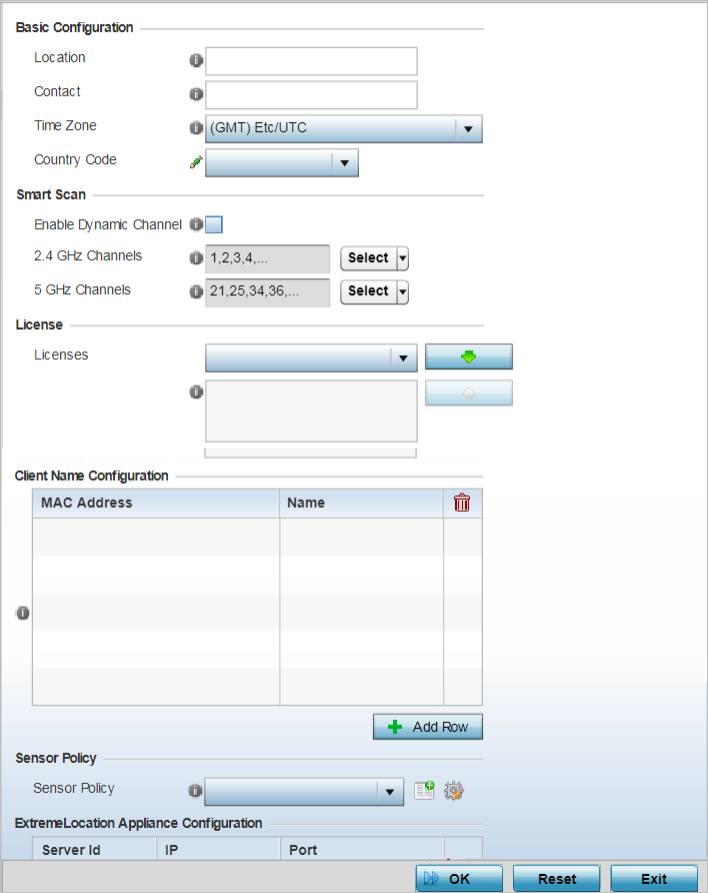Use RF Domain Overrides to define settings overriding a target device‘s original RF Domain configuration. An RF Domain allows an administrator to assign configuration data to multiple access points (of the same model) deployed in a common coverage area (floor, building or site). In such instances, there are many configuration attributes these devices share as their general client support roles are quite similar. However, device configurations may need periodic refinement from their original RF Domain administered design. Unlike a RFS series controller, an access point supports a single RF domain. An access point RF Domain cannot be used on a different model access point.
The Device Overrides screen displays. This screen lists devices within the managed network.
The selected access point's configuration menu displays, with the Basic configuration screen selected by default.
The RF Domain configuration overrides screen displays.


Note
A blue override icon (to the left of a parameter) defines the parameter as having an override applied. To remove a device‘s override, go to the Basic Configuration screen‘s Device Overrides field, and then select the Clear Overrides button.
|
Location |
Set the deployment location for the access point as part of its RF Domain configuration |
|
Contact |
Set the administrative contact for the access point. This should reflect the administrator responsible for the access point‘s configuration and wireless network. |
|
Time Zone |
Use the drop-down menu to select the geographic time zone supporting its deployment location |
|
Country Code |
Use the drop-down menu to select the country code supporting its deployment location |
|
Enable Dynamic Channel |
Select this option to enable dynamic channel scan. |
|
2.4 GHz Channels |
Use the Select drop-down menu to select channels to scan in the 2.4 GHz band. Selected channels are highlighted with a grey background. Unselected channels are highlighted with a white background. Multiple channels can be selected at the same time |
|
5.0 GHz Channles |
Use the Select drop-down menu to select channels to scan in the 5.0 GHz band. Selected channels are highlighted with a grey background. Unselected channels are highlighted with a white background. Multiple channels can be selected at the same time |
Enter the client‘s factory coded MAC address in the MAC Address field. Assign a name to the RF Domain member access point‘s connected client to assist in its easy recognition in the Name field.

Note
If a dedicated sensor is utilized with WIPS for rogue detection, any sensor policy selected from the Sensor Policy drop-down menu is discarded and not utilized by the sensor. To avoid this situation, use ADSP channel settings exclusively to configure the sensor and not the WiNG interface.
Select the Create icon to create a new sensor policy to apply to this RF Domain or select the Edit icon to update the configuration of an existing policy before applying it to the RF Domain. For more information, see Sensor Policy.
When configured, RF Domain access points use a Websocket to forward 802.11 frames and BLE beacons to the specified ExtremeLocation server.
Starting with WiNG 7.1.2, AP5XX APs will not use WIPS to collect WiFi packets and BLE (iBeacons and Eddystone) beacons. The information will be collected in the Collector Table and forwarded to the ExtremeLocation server from the Collector Table.
ExtremeLocation is a highly scalable indoor locationing platform that gathers location-related analytics, such as visitor trends, peak and off-peak times, dwell time, heat-maps, etc. to enable entrepreneurs deeper visibility at a venue. To enable the location tracking system, the ExtremeLocation server should be up and running and the RF Domain configuration should point to the ExtremeLocation server.
|
Server Id |
Use the spinner control to assign a numerical ID for the ExtremeLocation server resource. Note:
As of now only one server is supported. |
|
IP Address/Hostname |
Provide the hostname of the ExtremeLocation server resource for receiving RSSI scan data from the AP. Hostname cannot exceed 64 characters or contain an underscore. Note:
Enter the ExtremeLocation server‘s hostname and not the IP address, as the IP address is likely to change periodically in order to balance load across multiple Location server instances. |
|
Port |
Use the spinner control to specify the port of the ExtremeLocation server resource receiving RSSI scan data. Note:
By default, the ExtremeLocation server is reachable on port 443. |
Click Reset to revert to the last saved configuration.